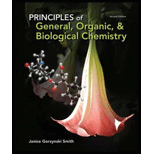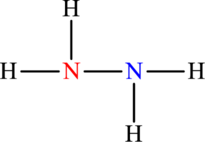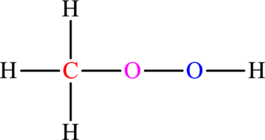
Principles of General, Organic, Biological Chemistry
2nd Edition
ISBN: 9780073511191
Author: Janice Gorzynski Smith Dr.
Publisher: McGraw-Hill Education
expand_more
expand_more
format_list_bulleted
Concept explainers
Question
Chapter 3, Problem 3.92AP
(a)
Interpretation Introduction
Interpretation:
Lone pairs have to added to the nitrogen atoms to give it an octet. The shape of nitrogen around the indicated atom in the given molecule has to be given.
The given molecule is,

(b)
Interpretation Introduction
Interpretation:
Lone pairs have to added to the oxygen atoms to give it an octet. The shape of carbon and oxygen around the indicated atom in the given molecule has to be given.
The given molecule is,

Expert Solution & Answer
Want to see the full answer?
Check out a sample textbook solution
Students have asked these similar questions
Don't used hand raiting and don't used Ai solution
10. The main product of the following reaction is [1.1:4',1"-terphenyl]-2'-yl(1h-pyrazol-4-
yl)methanone
Ph
N-H
Ph
Draw the Fischer projection for a D-aldo-pentose. (aldehyde pentose). How many total
stereoisomers are there? Name the sugar you drew.
Draw the Fischer projection for a L-keto-hexose. (ketone pentose). How many total
stereoisomers are there? Draw the enantiomer.
Chapter 3 Solutions
Principles of General, Organic, Biological Chemistry
Ch. 3.1 - Predict whether the bonds in the following species...Ch. 3.2 - Write the ion symbol for an atom with the given...Ch. 3.2 - Prob. 3.4PCh. 3.2 - Prob. 3.5PCh. 3.2 - How many electrons and protons are contained in...Ch. 3.2 - Prob. 3.7PCh. 3.3 - Write the formula for the ionic compound formed...Ch. 3.3 - Prob. 3.9PCh. 3.4 - Prob. 3.10PCh. 3.4 - Give the symbol for each ion. a. stannous b....
Ch. 3.4 - Name each ionic compound. a. NaF b. MgO c. SrBr2...Ch. 3.4 - Name each ionic compound. a. CrCl3 b. PbS c. SnF4...Ch. 3.4 - Prob. 3.14PCh. 3.5 - List four physical properties of ionic compounds.Ch. 3.6 - Write the formula for the compound formed when K+...Ch. 3.6 - Prob. 3.17PCh. 3.6 - Name each compound. a. Na2CO3 b. Ca(OH)2 c....Ch. 3.6 - Prob. 3.19PCh. 3.7 - Use electron-dot symbols to show how a hydrogen...Ch. 3.7 - Prob. 3.21PCh. 3.8 - Draw a Lewis structure for each covalent molecule....Ch. 3.8 - Prob. 3.23PCh. 3.8 - Prob. 3.24PCh. 3.9 - Prob. 3.25PCh. 3.9 - Prob. 3.26PCh. 3.10 - Prob. 3.27PCh. 3.11 - Prob. 3.28PCh. 3.11 - Prob. 3.29PCh. 3.11 - Show the direction of the dipole in each bond....Ch. 3.12 - Prob. 3.31PCh. 3.12 - Prob. 3.32PCh. 3 - Which formulas represent ionic compounds and which...Ch. 3 - Which pairs of elements are likely to form ionic...Ch. 3 - Prob. 3.35UKCCh. 3 - Prob. 3.36UKCCh. 3 - Prob. 3.37UKCCh. 3 - Prob. 3.38UKCCh. 3 - Prob. 3.39UKCCh. 3 - Prob. 3.40UKCCh. 3 - Prob. 3.41UKCCh. 3 - Prob. 3.42UKCCh. 3 - Prob. 3.43UKCCh. 3 - Prob. 3.44UKCCh. 3 - Prob. 3.45UKCCh. 3 - Prob. 3.46UKCCh. 3 - (a) Translate each ball-and-stick model to a Lewis...Ch. 3 - Prob. 3.48UKCCh. 3 - Prob. 3.49APCh. 3 - How many protons and electrons are present in each...Ch. 3 - Prob. 3.51APCh. 3 - Prob. 3.52APCh. 3 - Prob. 3.53APCh. 3 - Give the ion symbol for each ion. a. barium ion b....Ch. 3 - Prob. 3.65APCh. 3 - Write the formula for the ionic compound formed...Ch. 3 - Prob. 3.67APCh. 3 - Prob. 3.68APCh. 3 - Name each ionic compound. a. Na2O b. BaS c. PbS2...Ch. 3 - Name each ionic compound. a. KF b. ZnCl2 c. Cu2S...Ch. 3 - Prob. 3.71APCh. 3 - Write formulas to illustrate the difference...Ch. 3 - Prob. 3.73APCh. 3 - Name each ionic compound. a. (NH4)2SO4 b. NaH2PO4...Ch. 3 - Prob. 3.75APCh. 3 - Prob. 3.76APCh. 3 - Prob. 3.77APCh. 3 - Label each statement as true or false. Correct any...Ch. 3 - Prob. 3.79APCh. 3 - Prob. 3.80APCh. 3 - Prob. 3.81APCh. 3 - Prob. 3.82APCh. 3 - Convert the 3-D model of oxalic acid into a Lewis...Ch. 3 - Convert the 3-D model of the general anesthetic...Ch. 3 - Prob. 3.85APCh. 3 - Prob. 3.86APCh. 3 - Prob. 3.87APCh. 3 - Prob. 3.88APCh. 3 - Prob. 3.89APCh. 3 - Prob. 3.90APCh. 3 - Prob. 3.91APCh. 3 - Prob. 3.92APCh. 3 - Prob. 3.93APCh. 3 - Prob. 3.94APCh. 3 - Rank the atoms in each group in order of...Ch. 3 - Prob. 3.96APCh. 3 - Prob. 3.97APCh. 3 - Prob. 3.98APCh. 3 - Prob. 3.99APCh. 3 - Which bond in each pair is more polarthat is, has...Ch. 3 - Prob. 3.101APCh. 3 - Prob. 3.102APCh. 3 - Isobutyl cyanoacrylate is used in medical glues to...Ch. 3 - Prob. 3.104APCh. 3 - Prob. 3.105CPCh. 3 - Prob. 3.106CP
Knowledge Booster
Learn more about
Need a deep-dive on the concept behind this application? Look no further. Learn more about this topic, chemistry and related others by exploring similar questions and additional content below.Similar questions
- Draw a structure using wedges and dashes for the following compound: H- Et OH HO- H H- Me OHarrow_forwardWhich of the following molecules are NOT typical carbohydrates? For the molecules that are carbohydrates, label them as an aldose or ketose. HO Он ОН ОН Он ОН но ΤΗ HO ОН HO eve Он он ОН ОН ОН If polyethylene has an average molecular weight of 25,000 g/mol, how many repeat units are present?arrow_forwardDraw the a-anomer cyclized pyranose Haworth projection of the below hexose. Circle the anomeric carbons. Number the carbons on the Fischer and Haworth projections. Assign R and S for each chiral center. HO CHO -H HO -H H- -OH H -OH CH₂OH Draw the ẞ-anomer cyclized furanose Haworth projection for the below hexose. Circle the anomeric carbons. Number the carbons on the Fischer and Haworth projections. HO CHO -H H -OH HO -H H -OH CH₂OHarrow_forward
- Name the below disaccharide. Circle any hemiacetals. Identify the numbering of glycosidic linkage, and identify it as a or ẞ. OH HO HO OH HO HO HO OHarrow_forwardWhat are the monomers used to make the following polymers? F. а. b. с. d. Вецер хочому なarrow_forward1. Propose a reasonable mechanism for the following transformation. I'm looking for curved mechanistic arrows and appropriate formal charges on intermediates. OMe MeO OMe Me2N NMe2 OTBS OH xylenes OMe 'OTBSarrow_forward
- What is the polymer made from the following monomers? What type of polymerization is used for each? а. ОН H2N но b. ن -NH2 d. H₂N NH2 довarrow_forwardCondensation polymers are produced when monomers containing two different functional groups link together with the loss of a small molecule such as H2O. The difunctional monomer H2N(CH2)6COOH forms a condensation polymer. Draw the carbon-skeleton structure of the dimer that forms from this monomer.arrow_forwardWhat is the structure of the monomer?arrow_forward
- → BINDERIYA GANBO... BINDERIYA GANBO. AP Biology Notes Gamino acid chart - G... 36:22 司 10 ☐ Mark for Review Q 1 Hide 80 8 2 =HA O=A¯ = H₂O Acid HIO HBrO HCIO Question 10 of 35 ^ Σ DELL □ 3 % Λ & 6 7 * ∞ 8 do 5 $ 4 # m 3 ° ( 9 Highlights & Notes AXC Sign out Carrow_forwardWhich representation(s) show polymer structures that are likely to result in rigid, hard materials and those that are likely to result in flexible, stretchable, soft materials?arrow_forward3. Enter the molecular weight of the product obtained from the Williamson Ether Synthesis? OH OH & OH excess CH3l Ag₂Oarrow_forward
arrow_back_ios
SEE MORE QUESTIONS
arrow_forward_ios
Recommended textbooks for you
 Chemistry: Principles and PracticeChemistryISBN:9780534420123Author:Daniel L. Reger, Scott R. Goode, David W. Ball, Edward MercerPublisher:Cengage Learning
Chemistry: Principles and PracticeChemistryISBN:9780534420123Author:Daniel L. Reger, Scott R. Goode, David W. Ball, Edward MercerPublisher:Cengage Learning World of Chemistry, 3rd editionChemistryISBN:9781133109655Author:Steven S. Zumdahl, Susan L. Zumdahl, Donald J. DeCostePublisher:Brooks / Cole / Cengage Learning
World of Chemistry, 3rd editionChemistryISBN:9781133109655Author:Steven S. Zumdahl, Susan L. Zumdahl, Donald J. DeCostePublisher:Brooks / Cole / Cengage Learning Chemistry: The Molecular ScienceChemistryISBN:9781285199047Author:John W. Moore, Conrad L. StanitskiPublisher:Cengage Learning
Chemistry: The Molecular ScienceChemistryISBN:9781285199047Author:John W. Moore, Conrad L. StanitskiPublisher:Cengage Learning- Chemistry: Matter and ChangeChemistryISBN:9780078746376Author:Dinah Zike, Laurel Dingrando, Nicholas Hainen, Cheryl WistromPublisher:Glencoe/McGraw-Hill School Pub Co
 General Chemistry - Standalone book (MindTap Cour...ChemistryISBN:9781305580343Author:Steven D. Gammon, Ebbing, Darrell Ebbing, Steven D., Darrell; Gammon, Darrell Ebbing; Steven D. Gammon, Darrell D.; Gammon, Ebbing; Steven D. Gammon; DarrellPublisher:Cengage Learning
General Chemistry - Standalone book (MindTap Cour...ChemistryISBN:9781305580343Author:Steven D. Gammon, Ebbing, Darrell Ebbing, Steven D., Darrell; Gammon, Darrell Ebbing; Steven D. Gammon, Darrell D.; Gammon, Ebbing; Steven D. Gammon; DarrellPublisher:Cengage Learning Introductory Chemistry: An Active Learning Approa...ChemistryISBN:9781305079250Author:Mark S. Cracolice, Ed PetersPublisher:Cengage Learning
Introductory Chemistry: An Active Learning Approa...ChemistryISBN:9781305079250Author:Mark S. Cracolice, Ed PetersPublisher:Cengage Learning

Chemistry: Principles and Practice
Chemistry
ISBN:9780534420123
Author:Daniel L. Reger, Scott R. Goode, David W. Ball, Edward Mercer
Publisher:Cengage Learning

World of Chemistry, 3rd edition
Chemistry
ISBN:9781133109655
Author:Steven S. Zumdahl, Susan L. Zumdahl, Donald J. DeCoste
Publisher:Brooks / Cole / Cengage Learning

Chemistry: The Molecular Science
Chemistry
ISBN:9781285199047
Author:John W. Moore, Conrad L. Stanitski
Publisher:Cengage Learning

Chemistry: Matter and Change
Chemistry
ISBN:9780078746376
Author:Dinah Zike, Laurel Dingrando, Nicholas Hainen, Cheryl Wistrom
Publisher:Glencoe/McGraw-Hill School Pub Co

General Chemistry - Standalone book (MindTap Cour...
Chemistry
ISBN:9781305580343
Author:Steven D. Gammon, Ebbing, Darrell Ebbing, Steven D., Darrell; Gammon, Darrell Ebbing; Steven D. Gammon, Darrell D.; Gammon, Ebbing; Steven D. Gammon; Darrell
Publisher:Cengage Learning

Introductory Chemistry: An Active Learning Approa...
Chemistry
ISBN:9781305079250
Author:Mark S. Cracolice, Ed Peters
Publisher:Cengage Learning
Stoichiometry - Chemistry for Massive Creatures: Crash Course Chemistry #6; Author: Crash Course;https://www.youtube.com/watch?v=UL1jmJaUkaQ;License: Standard YouTube License, CC-BY
Bonding (Ionic, Covalent & Metallic) - GCSE Chemistry; Author: Science Shorts;https://www.youtube.com/watch?v=p9MA6Od-zBA;License: Standard YouTube License, CC-BY
General Chemistry 1A. Lecture 12. Two Theories of Bonding.; Author: UCI Open;https://www.youtube.com/watch?v=dLTlL9Z1bh0;License: CC-BY